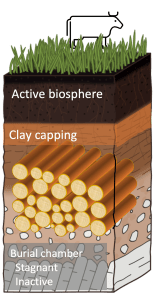Developing and deploying durable, cost-effective Wood Vault carbon removal.
A Hybrid Nature-Engineering Approach
Carbon Lockdown Project (CLP) utilizes Wood Vaults that harness the efficiency of photosynthesis, while solving for durability through a rigorous scientific approach based on the research of our Founder Dr. Ning Zeng. This will allow us to achieve gigaton scale by 2030 at a cost per tonne far below many other CDR approaches, yielding substantial benefits to forest ecosystems and rural communities.
Wood Vaults Explained

Our projects “hack” the global carbon cycle, by transitioning carbon from the fast biological carbon cycle to the slow geologic carbon cycle, a process that is similar to the first step of coal formation.
Sustainably sourced woody biomass is buried in an underground Wood Vault, encased in low-permeability soil, creating an anoxic environment that halts decomposition. Our Wood Vaults are engineered to ensure durability of 1,000 years or more, and can achieve high density storage (100k tonnes/ha) and high carbon efficiency (>90%).

Our 2030 Goals

Generate 4 million tonnes of durable carbon removal through Wood Vault projects.
Achieve an average cost per tonne of carbon removal below $100.

Contribute to forest restoration efforts across 100,000 acres

Drive $200M in revenue to rural forest communities
Carbon Lockdown is actively seeking project and partnership opportunities. Please contact us today to discuss Wood Vault project development.
Carbon Buyers

We develop projects under the Puro.Earth Terrestrial Storage of Biomass standard, generating verified CO₂ Removal Certificates (CORCs). These high-integrity carbon credits are available through fixed-price forward offtake agreements, providing corporate partners with price certainty and a reliable path to durable carbon removal.

Our projects produce a variety of co-benefits, including enhanced biodiversity by supporting nature restoration, reducing risks to native habitat of wildfire and pests, rural economic development, and accelerating recovery from storms and other catastrophic events.

We have a robust pipeline of projects set to deliver a substantial volume of high-quality carbon removal credits in the coming years. Our scalable Wood Vault method, with its short turnaround time, allows us to provide low-risk, consistent, and verifiable carbon removals.
Featured projects

The Potomac Project

The Montreal Project


